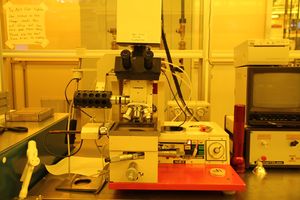IR Aligner (SUSS MJB-3 IR): Difference between revisions
Jump to navigation
Jump to search
Content deleted Content added
Contact info changed to Lee S. |
SOP rev |
||
| (6 intermediate revisions by 2 users not shown) | |||
| Line 11: | Line 11: | ||
|toolid=32 |
|toolid=32 |
||
}} |
}} |
||
= |
==About== |
||
This is a high-performance mask aligner |
This is a high-performance contact mask aligner with backside alignment capability for opaque materials using IR. It is a versatile, user-friendly compact unit that has a foot print of 600 x 800 mm². The resolution (depending on contact mode, optics and exposure wavelength and "operator technique") is down to 1 micron (hard contact). The aligner is configured for the near-UV window (365 and 405 nm). Exposures can be done on substrates from small "piece parts" of less than 1 cm square to substrates of 3 inch diameter or square. Masks up to 4 inches in size can be used although patterns should be well away from the mask plate edges due to the fact such plates can only be shifted a limited distance in the x and y. |
||
| ⚫ | |||
| ⚫ | |||
*Wafer size: 3" max. for vacuum mode; 4” for soft contact (3” x 3” exposure area) |
*Wafer size: 3" max. for vacuum mode; 4” for soft contact (3” x 3” exposure area) |
||
*Substrate size: 3" x 3" max. |
*Substrate size: 3" x 3" max. |
||
*Wafer / substrate thickness: 0-4.5 mm |
*Wafer / substrate thickness: 0-4.5 mm |
||
*Exposure optics: |
*Exposure optics: |
||
** |
**280-450 nm/200 W mercury lamp (can filter to 350 nm) |
||
| ⚫ | |||
**IR unit: 280-450 nm/200 W mercury lamp |
|||
*Additional manufacturer options (none installed on our systems): |
|||
**DUV (polychromatic): 240-260 nm/350 W Cd-Xe lamp; 0.2 micron resolution (PMMA) |
|||
**DUV (monochromatic): 248 nm/KrF excimer laser; 0.3 micron resolution (PMMA) |
|||
**193 nm/ArF excimer laser; 0.2 micron resolution (PMMA) |
|||
*Uniformity: |
*Uniformity: |
||
**±3% over 2" diameter |
**±3% over 2" diameter |
||
**±5% over 3" diameter |
**±5% over 3" diameter |
||
=Special Notes / Additional Comments= |
==Special Notes / Additional Comments== |
||
*All units have 200 W mercury lamps |
|||
| ⚫ | |||
| ⚫ | |||
*Top side alignment (visible) can be performed on this aligner as well with a quick tooling change |
|||
*All models can be equipped for back side alignment using infrared light; this is used when a mask needs to be aligned to features on the substrate backside but exposed to light on the front or resist side |
|||
| ⚫ | |||
| ⚫ | |||
| ⚫ | |||
| ⚫ | |||
*This aligner does not support vacuum contact mode |
|||
*For processes using this tool please go to the contact lithography process page |
*For processes using this tool please go to the contact lithography process page |
||
*This includes: |
|||
==Documentation== |
|||
*Modified alignment stage |
|||
| ⚫ | |||
*[https://wiki.nanotech.ucsb.edu/wiki/images/d/de/MJB_3_SOP.pdf MJB 3 Standard Operating Procedure] |
|||
| ⚫ | |||
*[https://wiki.nanotech.ucsb.edu/w/images/1/11/MJB_3_IR_Alignment_Mode_Conversion.pdf MJB 3 IR Alignment Mode Conversion Procedure] |
|||
| ⚫ | |||
*[https://wiki.nanotech.ucsb.edu/w/images/7/70/MJB_3_IR_Camera_SOP_Rev_B.pdf MJB 3 IR Camera Operating Procedure] |
|||
*(Note: The vacuum contact mode is not allowed in the ITA System) |
|||
Latest revision as of 18:56, 7 August 2020
|
About
This is a high-performance contact mask aligner with backside alignment capability for opaque materials using IR. It is a versatile, user-friendly compact unit that has a foot print of 600 x 800 mm². The resolution (depending on contact mode, optics and exposure wavelength and "operator technique") is down to 1 micron (hard contact). The aligner is configured for the near-UV window (365 and 405 nm). Exposures can be done on substrates from small "piece parts" of less than 1 cm square to substrates of 3 inch diameter or square. Masks up to 4 inches in size can be used although patterns should be well away from the mask plate edges due to the fact such plates can only be shifted a limited distance in the x and y.
Detailed Specifications
- Wafer size: 3" max. for vacuum mode; 4” for soft contact (3” x 3” exposure area)
- Substrate size: 3" x 3" max.
- Wafer / substrate thickness: 0-4.5 mm
- Exposure optics:
- 280-450 nm/200 W mercury lamp (can filter to 350 nm)
- Uniformity:
- ±3% over 2" diameter
- ±5% over 3" diameter
Special Notes / Additional Comments
- 200 W mercury lamp
- Top side alignment (visible) can be performed on this aligner as well with a quick tooling change
- Infrared Transmission Alignment System:
- Motor positioned IR light source under chuck
- Special glass chucks transparent to IR but opaque to UV and visible light
- In-line video camera/monitor for substrate backside viewing and alignment to front-side
- This aligner does not support vacuum contact mode
- For processes using this tool please go to the contact lithography process page
